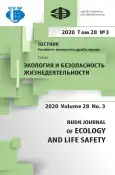Influence of the shape and size of the ground targets on the accuracy of photogrammetric processing
- Autores: Elsheshtawy A.1,2, Gavrilova L.A.2, Limonov A.N.2, Elshewy M.1,2
-
Afiliações:
- Al-Azhar University
- State University of Land Use Planning
- Edição: Volume 28, Nº 3 (2020)
- Páginas: 293-304
- Seção: Environmetal defence
- URL: https://journal-vniispk.ru/2313-2310/article/view/323897
- DOI: https://doi.org/10.22363/2313-2310-2020-28-3-293-304
- ID: 323897
Citar
Texto integral
Resumo
The materials obtained from the unmanned aerial vehicle (UAV) are used to solve many problems, including large-scale mapping and monitoring of linear objects, as well as the ecological situation and monitoring of emergency situations. The promptly obtained photographic materials make it possible to reveal the consequences of man-made human impact associated with degradation of the soil cover, flooding of lands, salinization and pollution of the soil layer, and changes in the vegetation cover. Control points are used for absolute orientation of the generated models in the most projects of photogrammetric processing of aerial photos and images obtained from UAVs. In areas with low contour, before aerial survey, targeting is carried out in the required zones. The research is devoted to the study of the influence of the shape of ground targets on the accuracy of photogrammetric processing. It involved three different types of ground targets located on the land cover along the survey path at a distance not exceeding 1 m from each other. The targets were used as ground control points in the photogrammetric processing of the materials from the UAV. Two three-stripe photographic surveys of the 900 m long track were carried out: with UAV DJI PHANTOM 4 PRO camera FC6310 at a scale of 1:3400 and ground resolution of 1 cm and with the DJI Mavic PRO UAV camera FC220 at a scale of 1:12 700 and ground resolution of 2 cm. In both cases, the direction of flight is north - south, 36 targets were included in the photogrammetric processing. In the first case, 502 images were processed, in the second - 152. The photogrammetric processing for the orthophoto mosaic generation was carried out using the Agisoft Photo Scan Professional software. Four different contrasting sites in the study area were selected for the study: green grass, dry grass, clay, sand. Accuracy was assessed according to two criteria: 1) the degree of visualization of the target on the images; 2) the accuracy of the orthophoto mosaic, generated using various targets.
Palavras-chave
Sobre autores
Amr Elsheshtawy
Al-Azhar University; State University of Land Use Planning
Autor responsável pela correspondência
Email: amrshesht82@gmail.com
PhD student at the Department of Remote Sensing and Digital Cartography of the State University of Land Use Planning; teacher of the Civil Engineering Department of the Faculty of Engineering in Cairo of the Al-Azhar University
15 Mohammed Abdou St, El-Darb El-Ahmar, Cairo Governorate, Arab Republic of Egypt; 15 Kazakova St., Moscow, 105064, Russian FederationLarisa Gavrilova
State University of Land Use Planning
Email: gavrilova.a.larisa@gmail.com
Candidate of Technical Sciences, Associate Professor, Dean of the Faculty of Urban Cadaster
15 Kazakova St., Moscow, 105064, Russian FederationAnatoly Limonov
State University of Land Use Planning
Email: limonov.anatoly@gmail.com
Candidate of Technical Sciences, Associate Professor, Professor of the Department of Remote Sensing and Digital Cartography
15 Kazakova St., Moscow, 105064, Russian FederationMohamed Elshewy
Al-Azhar University; State University of Land Use Planning
Email: mimoelshewy@gmail.com
PhD student at the Department of Geodesy and Geoinformatics of the State University of Land Use Planning; teacher of the Civil Engineering Department of the Faculty of Engineering in Cairo of the Al-Azhar University.
15 Mohammed Abdou St, El-Darb El-Ahmar, Cairo Governorate, Arab Republic of Egypt; 15 Kazakova St., Moscow, 105064, Russian FederationBibliografia
- Jaal Z, Abdullah J. User's preferences of highway landscapes in Malaysia: a review and analysis of the literature. Procedia. Social and Behavioral Sciences. 2012;36;265-272.
- Albattah MMS. Optimum highway design and site location using spatial geoinformatics engineering. Journal of Remote Sensing & GIS. 2016;5(1):10.
- Instruktsiya po topograficheskim s"emkam v masshtabakh 1:10000 i 1:25000 [Instructions for topographic surveys at scales 1:10000 and 1:25000]. Moscow: Nedra Publ.; 1978. (In Russ.)
- Instruktsiya po topograficheskoi s"emke v masshtabakh 1:500, 1:1000, 1:2000 i 1:5000 [Instructions for topographic survey at scales 1:500, 1:1000, 1:2000 and 1:5000]. Moscow: Nedra Publ.; 1983. (In Russ.)
- Wang J, Ge Y, Heuvelink GB, Zhou C, Brus D. Effect of the sampling design of ground control points on the geometric correction of remotely sensed imagery. Int. J. Appl. Earth Obs. 2012;18:91-100.
- Hugenholtz CH, Whitehead K, Brown OW, Barchyn TE, Moorman BJ, LeClair A, Riddell K, Hamilton T. Geomorphological mapping with a small unmanned aircraft system (sUAS): feature detection and accuracy assessment of a photogrammetrically derived digital terrain model. Geomorphology. 2013;194:16-24.
- Patias P, Giagkas F, Georgiadis C, Mallinis G, Kaimaris D, Tsioukas V. Evaluating horizontal positional accuracy of low-cost UAV orthomosaics over forest terrain using ground control points extracted from different sources. Proceedings of the International Conference on Remote Sensing and Geoinformation of the Environment, International Society for Optics and Photonics, Paphos, Cyprus, 20-23 March 2017; p. 104440U.
- Turner D, Lucieer A, Wallace L. Direct georeferencing of ultrahigh-resolution UAV imagery. IEEE Trans. Geosci. Remote Sens. 2014;52:2738-2745.
- Wells RR, Momm HG, Castillo C. Quantifying uncertainty in high-resolution remotely sensed topographic surveys for ephemeral gully channel monitoring. Earth Surf. Dyn. 2017;5:347.
- Propeller. Available from: https://www.propelleraero.com/aeropoints/ (accessed: 10.08.2018).
Arquivos suplementares









